Art, sea and city - COCHIN BIENNALE 2014
I travelled to Cochin during the Christmas eve of 2014. The focus of the trip was Fort Cochin. The protagonist was drenched in the spirit of Biennale. Biennale is a contemporary art festival that pitches itself once in every two years. During the festival, the sleepy town of fort Cochin with its 2000 inhabitants transforms itself into a thriving hub of art and tourism.

The setting welcomes all kind of tourists from local to international, from backpackers who would trod open the city on foot to ones who would splurge in hospitality in God's own country, to young enthusiasts like us (me and Anubhav) who would travel places in search of genius loci ( the spirit of the place) to others who come to the city over and over again, sometimes in search of a reminiscing nostalgia and sometimes to observe the transformation.
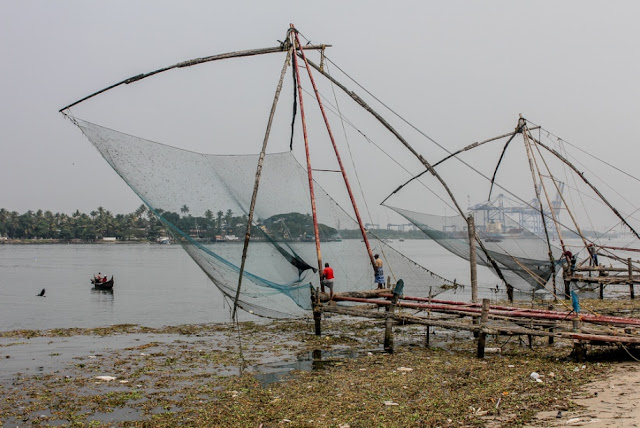
We reached Cochin by mid-day , on the eve of Christmas. The city looked all propped up with lights and decoration for its Christmas carnival. All the maidaans in the city were being flocked up by people in mood of festivity. On reaching the Vasco Da Gama square, we could see the first installation of Biennale art festival. It was a sculpture made out of waste materials depicting a typical Indian ropewalker.
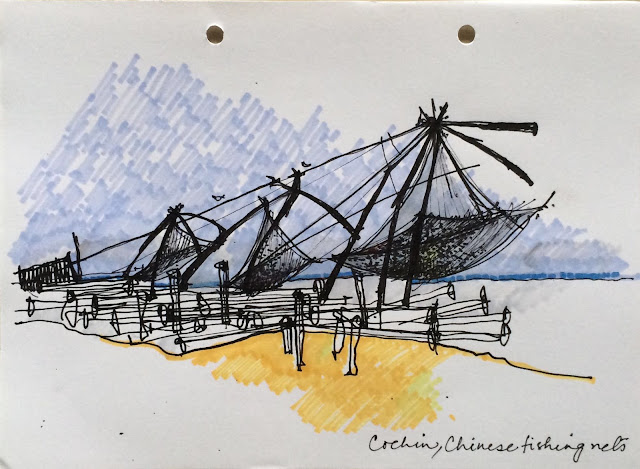
The setting of the sea with picturesque Chinese fishing nets by one side, and colonial heritage buildings on the other, it gave a quirky insight to all what awaited us in the art festival. On reaching our home stay, we realised that it was too late to venture out in the city for the festival. Instead we decided to go and watch a Kathakali recital.

The colours used are natural dyes in oil base.

The paper mask is being fixed with rice paste.

Kathakali is one of the seven classical dance forms in India. In form, it is a dance drama and can only be practised by men. Its known for its elaborate mask-attire and making. While I was all busy and mesmerized in observing the process, Anubhav captured this in form of a picture story.

Red, evil and expressive-ness.
The plot is generally inspired from mythological stories and culminates with the victory of good over evil. The good character is in green and the evil one is in red.

The good, the evil and the Natraja- the Lord of the dance.


And the show begins.

The conversation , the plead for the help to fight evil.
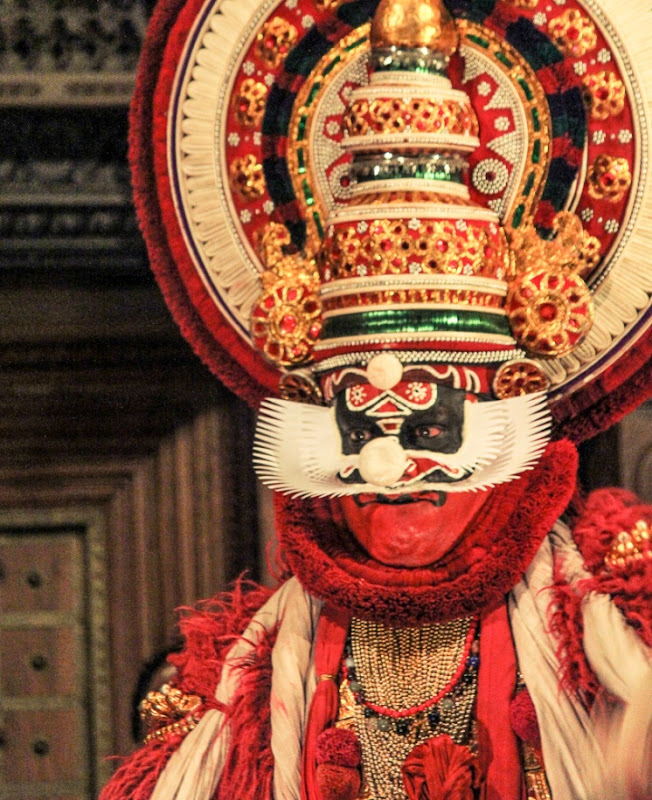
The tussle- the good and the evil.

The climax and the fall of evil.
The next morning started with exploring the Biennale festival . The main stay of the festival was in the Aspin wall house. It had over 200 artists exhibiting .The themes varied from technology to arts to philosophical broodings. The day quickly passed over.

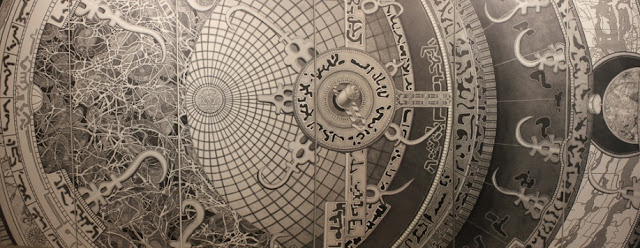
Art work :The other way of the world
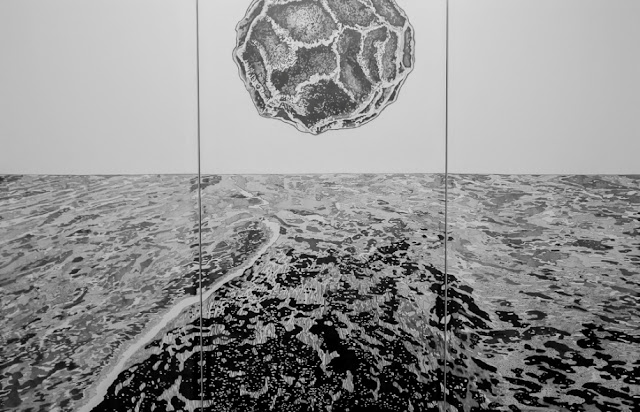
Artwork :what if the earth Hung over ??
And we spent the evening at Oceanos, eating some fresh sea food. While Anubhav stuck safe with some pasta sprinkled with prawns, while I was in all mood to try Pollichattu. Polichattu is a local Malabar preparation, owing its evolution to the colonial legacy.
Next day, we continued to the other venues of the Biennale. It spread over David Hall, Pepper House residency, Parade ground and others. We strolled through some, yawned at some and really enjoyed some. The festival would have been over in another month or so, but the spirit of biennale would live on. The wall murals we came across were really quirky. These were global media icons who were given a local malyali twist. So be Mona Lisa or Marilyn Monroe in tonnes of gold jewellery and kasavu saree or the mask man in kathakali attire. The pun just looked appropriate and awesome. Anubhav really enjoyed capturing some and here they are:


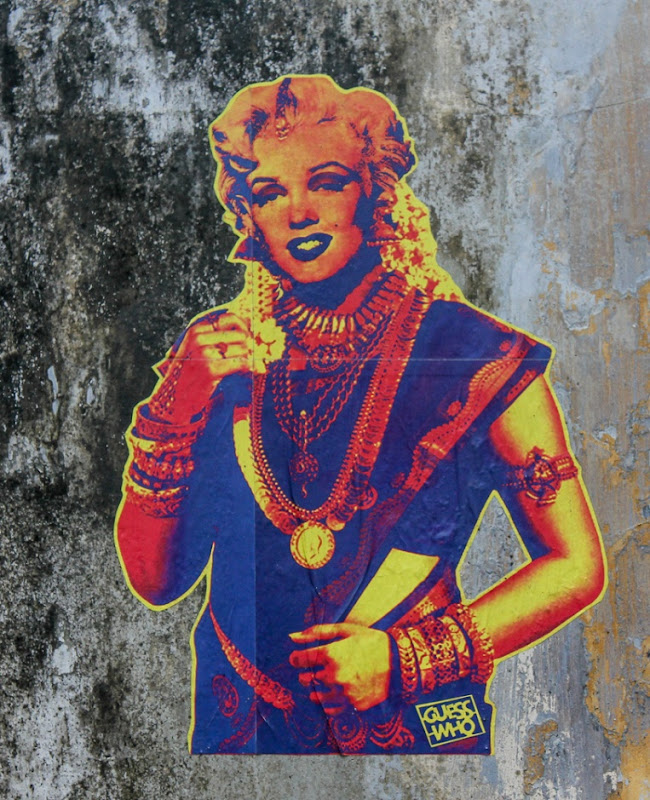




The festival was well curated to use the city as the canvas. It appreciated the city's old infrastructure and setting . In the evening we decided to take cycles and visit few jetties in the outskirt of the city. Mattancherry palace has, indeed, the best and the richest mural walls . It is the Dutch palace set around a Hindu temple. This is what is interesting and sort of, layered about Indian colonial legacy. It took its foreign foothold and lay itself across Indian sub-continent percolating all its nooks, cracks and crevices. I guess, therefore, objects (and subjects) of colonial history are of such interests.
After Mattancherry Palace, we strolled around the spice market and the Jew town. It is the only Jew town in country and has its own synagogue and cemetery . We biked around the area, saw some partner project of Biennale in the Jew town and retired back in the homestay for the evening.




The jetties around the Jew town
Next day we planned to spend at Cherai beach. Because the city's geography ( cochin is a set of dispersed islands) we decided to do the journey part ferry and part bus. The ferry ride was quite fun and it cost us exactly 2 rupees 50 paisa in 2014. The buses in Kerala are quite a type. It still looks the ones we had in 1980's devoid of any new technical changes, it is quite a nostalgic journey. But Cherai is one of the cleanest beaches in Cochin and we spent some peaceful time in sea, sand and water. As the evening fell by, we were ready to leave back for Bangalore and rejoin our workplaces for 2015.

All in all Cochin YOU taught us a lot.
About the Authors:
Disha, the writer of this post is based out of Bangalore and Delhi in India. She has been trained as an architect and kathak dancer. In her leisure time she likes to sketch, read, travel, do some photography, try various cuisines, indulge in some soulful music and do some soul brooding. She blogs at www.dishasahu.com, which is a memorabilia of her journey as a travel artist.
All the photographs in the post are done by Anubhav. He describes himself as an engineer who loves to travel with a camera. You can follow him on his blog www.anubhavtyagi.com

The setting welcomes all kind of tourists from local to international, from backpackers who would trod open the city on foot to ones who would splurge in hospitality in God's own country, to young enthusiasts like us (me and Anubhav) who would travel places in search of genius loci ( the spirit of the place) to others who come to the city over and over again, sometimes in search of a reminiscing nostalgia and sometimes to observe the transformation.

We reached Cochin by mid-day , on the eve of Christmas. The city looked all propped up with lights and decoration for its Christmas carnival. All the maidaans in the city were being flocked up by people in mood of festivity. On reaching the Vasco Da Gama square, we could see the first installation of Biennale art festival. It was a sculpture made out of waste materials depicting a typical Indian ropewalker.

The setting of the sea with picturesque Chinese fishing nets by one side, and colonial heritage buildings on the other, it gave a quirky insight to all what awaited us in the art festival. On reaching our home stay, we realised that it was too late to venture out in the city for the festival. Instead we decided to go and watch a Kathakali recital.

The colours used are natural dyes in oil base.

The paper mask is being fixed with rice paste.

Kathakali is one of the seven classical dance forms in India. In form, it is a dance drama and can only be practised by men. Its known for its elaborate mask-attire and making. While I was all busy and mesmerized in observing the process, Anubhav captured this in form of a picture story.

Red, evil and expressive-ness.
The plot is generally inspired from mythological stories and culminates with the victory of good over evil. The good character is in green and the evil one is in red.

The good, the evil and the Natraja- the Lord of the dance.


And the show begins.

The conversation , the plead for the help to fight evil.

The tussle- the good and the evil.

The climax and the fall of evil.
The next morning started with exploring the Biennale festival . The main stay of the festival was in the Aspin wall house. It had over 200 artists exhibiting .The themes varied from technology to arts to philosophical broodings. The day quickly passed over.


Art work :The other way of the world

Artwork :what if the earth Hung over ??
And we spent the evening at Oceanos, eating some fresh sea food. While Anubhav stuck safe with some pasta sprinkled with prawns, while I was in all mood to try Pollichattu. Polichattu is a local Malabar preparation, owing its evolution to the colonial legacy.
Next day, we continued to the other venues of the Biennale. It spread over David Hall, Pepper House residency, Parade ground and others. We strolled through some, yawned at some and really enjoyed some. The festival would have been over in another month or so, but the spirit of biennale would live on. The wall murals we came across were really quirky. These were global media icons who were given a local malyali twist. So be Mona Lisa or Marilyn Monroe in tonnes of gold jewellery and kasavu saree or the mask man in kathakali attire. The pun just looked appropriate and awesome. Anubhav really enjoyed capturing some and here they are:







The festival was well curated to use the city as the canvas. It appreciated the city's old infrastructure and setting . In the evening we decided to take cycles and visit few jetties in the outskirt of the city. Mattancherry palace has, indeed, the best and the richest mural walls . It is the Dutch palace set around a Hindu temple. This is what is interesting and sort of, layered about Indian colonial legacy. It took its foreign foothold and lay itself across Indian sub-continent percolating all its nooks, cracks and crevices. I guess, therefore, objects (and subjects) of colonial history are of such interests.
After Mattancherry Palace, we strolled around the spice market and the Jew town. It is the only Jew town in country and has its own synagogue and cemetery . We biked around the area, saw some partner project of Biennale in the Jew town and retired back in the homestay for the evening.




The jetties around the Jew town
Next day we planned to spend at Cherai beach. Because the city's geography ( cochin is a set of dispersed islands) we decided to do the journey part ferry and part bus. The ferry ride was quite fun and it cost us exactly 2 rupees 50 paisa in 2014. The buses in Kerala are quite a type. It still looks the ones we had in 1980's devoid of any new technical changes, it is quite a nostalgic journey. But Cherai is one of the cleanest beaches in Cochin and we spent some peaceful time in sea, sand and water. As the evening fell by, we were ready to leave back for Bangalore and rejoin our workplaces for 2015.

All in all Cochin YOU taught us a lot.
About the Authors:
Disha, the writer of this post is based out of Bangalore and Delhi in India. She has been trained as an architect and kathak dancer. In her leisure time she likes to sketch, read, travel, do some photography, try various cuisines, indulge in some soulful music and do some soul brooding. She blogs at www.dishasahu.com, which is a memorabilia of her journey as a travel artist.
All the photographs in the post are done by Anubhav. He describes himself as an engineer who loves to travel with a camera. You can follow him on his blog www.anubhavtyagi.com



































